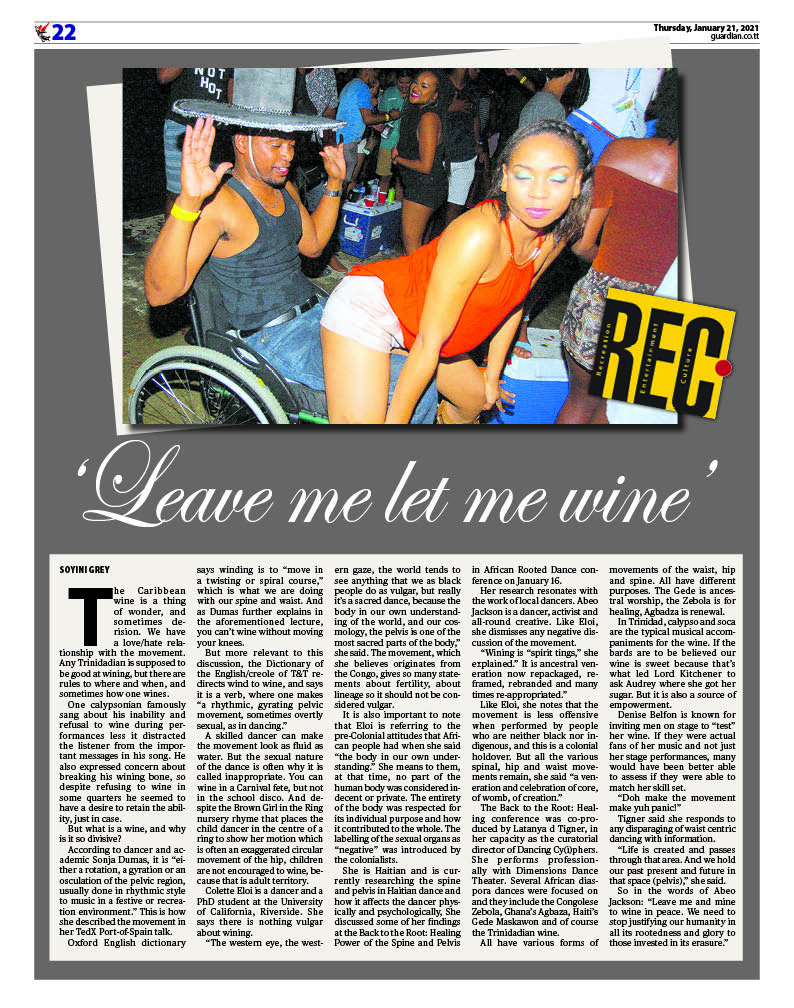Originally published in the Trinidad Guardian in January 2021 under the title ‘Leave me let me wine” this article and video that explored the history of our wine, so the conference mentioned took place in 2021.
The Caribbean wine is a thing of wonder, and sometimes derision. We have a love/hate relationship with the movement. Any Trinidadian is supposed to be good at wining, but there are rules to where and when, and sometimes how one wines. One calypsonian famously sang about his inability, and refusal to wine during performances less it distracted the listener from the important messages in his song. He also expressed concern about breaking his wining bone, so despite refusing to wine in some quarters he seemed to have a desire to retain the ability, just in case.
But what is a wine, and why is it so divisive? According to dancer and academic Sonja Dumas it is “either a rotation, a gyration or an osculation of the pelvic region, usually done in rhythmic style to music in a festive or recreation environment”. This is how she described the movement in her TedXPort of Spain talk.
Oxford English dictionary says winding is to “move in a twisting or spiral course,” which is what we are doing with our spine and waist. And as Dumas further explains in the aforementioned lecture, you can’t wine without moving your knees.
But more relevant to this discussion, the Dictionary of the English/Creole of Trinidad and Tobago redirects wind to wine, and says it is a verb, where one makes “a rhythmic, gyrating pelvic movement, sometimes overtly sexual, as in dancing.”
A skilled dancer can make the movement look as fluid as water. But the sexual nature of the dance is often why it is called inappropriate. You can wine in a Carnival fete, but not in the school disco. And despite the Brown Girl in the Ring nursery rhyme that places the child dancer in the centre of a ring to show her motion which is often an exaggerated circular movement of the hip, children are not encouraged to wine, because that is adult territory.
Colette Eloi is a dancer and a PhD student at the University of California, Riverside. She says there is nothing vulgar about wining.
“The western eye, the western gaze, the world tends to see anything that we as black people do as vulgar, but really it’s a sacred dance, because the body in our own understanding of the world, and our cosmology, the pelvis is one of the most sacred parts if the body,” she said. The movement, which she believes originates from Congo, gives so many statements about fertility, about lineage so it should not be considered vulgar.
It is also important to note that Eloi is referring to the pre-Colonial attitudes that African people had when she said “the body in our own understanding.” She means to them, at that time, no part of the human body was considered indecent or private. The entirety of the body was respected for its individual purpose and how it contributed to the whole. The labelling of the sexual organs as “negative” was introduced by the Colonialists.
She is Haitain and is currently researching the spine and pelvis in Haitian dance and how it effects the dancer physically and psychologically, She discussed some of her findings at the Back to the Root: Healing Power of the Spine and Pelvis in African Rooted Dance conference on Saturday 16th January.
Her research resonates with the work of local dancers. Abeo Jackson is a dancer, activist and all round creative. Like Eloi she dismisses any negative discussion of the movement.
“Wining is “spirit tings,” she explained.” It is ancestral veneration now repackaged, reframed, rebranded and many times re-appropriated.” Like Eloi she notes that the movement is less offensive when performed by people who are neither black nor indigenous, and this is a colonial holdover. But all the various spinal, hip and waist movements remain, she said “a veneration and celebration of core, of womb, of creation.”
The Back to the Root: Healing conference was co-produced by Latanya d. Tigner, in her capacity as the curatorial director of Dancing Cy(i)phers. She performs professionally with Dimensions Dance Theater. Several African diaspora dances were forcused on and they include the Congolese Zebola, Ghana’s Agbaza, Haiti’s Gede Maskawon and of course the Trinidadian wine.
All have various forms of movements of the waist, hip and spine. All have different purposes. The Gede is ancestral worship, the Zebola is for healing, Agbadza is renewal.
In Trinidad, calypso and soca are the typical musical accompaniments for the wine. If the bards are to be believed our wine is sweet, because that’s what led Lord Kitchener to ask Audrey where she got her sugar. But it is also a source of empowerment. Denise Belfon is known for inviting men on stage to “test” her wine. If they were actual fans of her music, and not just her stage performances, many would have been better able to assess if they were able to match her skill set.
“Doh make the movement make yuh panic!”
Tigner said she responds to any disparaging of waist centric dancing with information. “Life is created and passes through that area. And we hold our past present and future in that space (pelvis),” she said.
So in the words of Abeo Jackson, “Leave me and mine to wine in peace. We need to stop justifying our humanity in all its rootedness and glory to those invested in its erasure.”

Leave a Reply to Kongo Dey – thiscaribbeanspace Cancel reply